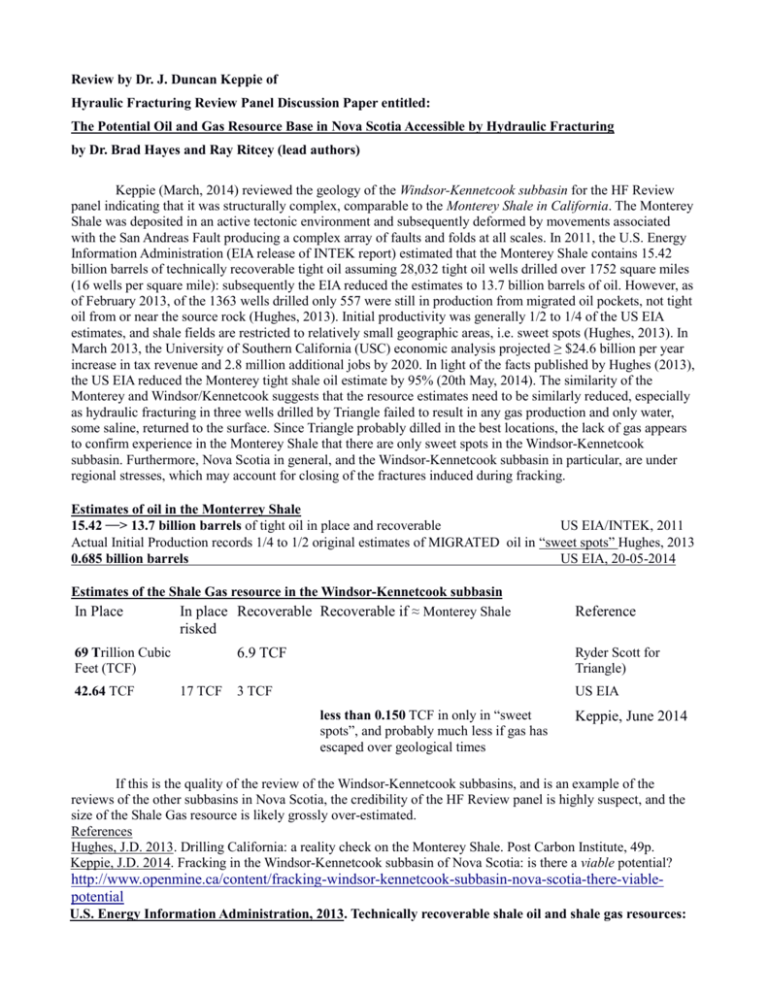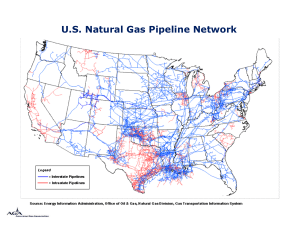Dunan Keppie 2
advertisement

Review by Dr. J. Duncan Keppie of Hyraulic Fracturing Review Panel Discussion Paper entitled: The Potential Oil and Gas Resource Base in Nova Scotia Accessible by Hydraulic Fracturing by Dr. Brad Hayes and Ray Ritcey (lead authors) Keppie (March, 2014) reviewed the geology of the Windsor-Kennetcook subbasin for the HF Review panel indicating that it was structurally complex, comparable to the Monterey Shale in California. The Monterey Shale was deposited in an active tectonic environment and subsequently deformed by movements associated with the San Andreas Fault producing a complex array of faults and folds at all scales. In 2011, the U.S. Energy Information Administration (EIA release of INTEK report) estimated that the Monterey Shale contains 15.42 billion barrels of technically recoverable tight oil assuming 28,032 tight oil wells drilled over 1752 square miles (16 wells per square mile): subsequently the EIA reduced the estimates to 13.7 billion barrels of oil. However, as of February 2013, of the 1363 wells drilled only 557 were still in production from migrated oil pockets, not tight oil from or near the source rock (Hughes, 2013). Initial productivity was generally 1/2 to 1/4 of the US EIA estimates, and shale fields are restricted to relatively small geographic areas, i.e. sweet spots (Hughes, 2013). In March 2013, the University of Southern California (USC) economic analysis projected ≥ $24.6 billion per year increase in tax revenue and 2.8 million additional jobs by 2020. In light of the facts published by Hughes (2013), the US EIA reduced the Monterey tight shale oil estimate by 95% (20th May, 2014). The similarity of the Monterey and Windsor/Kennetcook suggests that the resource estimates need to be similarly reduced, especially as hydraulic fracturing in three wells drilled by Triangle failed to result in any gas production and only water, some saline, returned to the surface. Since Triangle probably dilled in the best locations, the lack of gas appears to confirm experience in the Monterey Shale that there are only sweet spots in the Windsor-Kennetcook subbasin. Furthermore, Nova Scotia in general, and the Windsor-Kennetcook subbasin in particular, are under regional stresses, which may account for closing of the fractures induced during fracking. Estimates of oil in the Monterrey Shale 15.42 ―> 13.7 billion barrels of tight oil in place and recoverable US EIA/INTEK, 2011 Actual Initial Production records 1/4 to 1/2 original estimates of MIGRATED oil in “sweet spots” Hughes, 2013 0.685 billion barrels US EIA, 20-05-2014 Estimates of the Shale Gas resource in the Windsor-Kennetcook subbasin In Place In place Recoverable Recoverable if ≈ Monterey Shale Reference risked 69 Trillion Cubic Feet (TCF) 42.64 TCF 17 TCF 6.9 TCF Ryder Scott for Triangle) 3 TCF US EIA less than 0.150 TCF in only in “sweet spots”, and probably much less if gas has escaped over geological times Keppie, June 2014 If this is the quality of the review of the Windsor-Kennetcook subbasins, and is an example of the reviews of the other subbasins in Nova Scotia, the credibility of the HF Review panel is highly suspect, and the size of the Shale Gas resource is likely grossly over-estimated. References Hughes, J.D. 2013. Drilling California: a reality check on the Monterey Shale. Post Carbon Institute, 49p. Keppie, J.D. 2014. Fracking in the Windsor-Kennetcook subbasin of Nova Scotia: is there a viable potential? http://www.openmine.ca/content/fracking-windsor-kennetcook-subbasin-nova-scotia-there-viablepotential U.S. Energy Information Administration, 2013. Technically recoverable shale oil and shale gas resources: an assessment of 137 shale formations in 41 countries outside the US. June 2013, Washington, D.C. As a result of this review a number of questions arise: 1. How can the HF Review panel be considered “independent” when the lead authors for this Discussion paper both have, or are, working for Petroleum-related companies? 2. Why are there no geologists with knowledge of the local Nova Scotia geology on the HF Review panel, especially as there are several such people available in govenment, academia and recently retired? 3. Why did the authors of the Resource Discussion paper not evaluate the differences in the estimates of the sizes of the Shale Gas resource in the Windsor-Kennetcook subbasin? 4. Why did the HF Review merely repeat previous estimates of the size of the Shale Gas resource in the Windsor-Kennetcook subbasin, rather than using their “expertise” to provide revised estimates as is done in the Table above? 5. As the size of the resource forms the foundation for everything else that the HF Review panel is reviewing, why did the HF Review panel release the Economic Discussion paper before the Resource paper? 6. Why did the authors of the Resource Discussion paper not refer to any of the numerous geological reports and maps produced by goverment geologists, especially in view of the CBC Radio 1 Mainstreet interview where Dr. Wheeler said the Review Panel had got their information from the NS Department of Energy? 7. How could the HF panel have reveived all the data they required from the Department of Energy when the Departtment of Energy, realizing the lack of basic information, has budgeted $95,000 this fiscal year to produce a basic geological database? 8. If the HF Review panel got geological information from the NS Department of Energy, why are there no Government Reports and Maps on the HF Review website and none are referenced in the Resource Discussion paper? 9. In the complexly faulted, fractured and folded, Windsor-Kennetcook subbasin, is it possible that much of the shale gas has already been released to the atmosphere in the geological past? 10. Would man-made fracks intersecting naturally-occurring faults/fractures lead to escape of gas and fracking fluids? 11. As only 15% of the water pumped into the wells was recovered, did the rest go into pre-existing fractures and/or faults?







